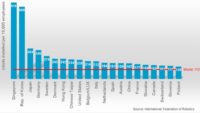FRANKFURT, Germany—The United States ranks 10th in the world in robot density, the number of operational industrial robots relative to the number of employees.
The number of employees serves as a measure of economic size, so the quotient of robots over employees puts the operational stock on a uniform base.
The top most automated countries measured by robot density are the Republic of Korea (1,012 robots per 10,000 employees), Singapore (730 units) and Germany (415 units), according to the International Federation of Robotics (IFR).
“Robot density data reveal the state of automation worldwide and allow us to compare regions and countries,” says Marina Bill, president of IFR and group vice president and head of marketing and sales for robotics and discrete automation at ABB. “The speed of robotics adoption in factories around the world is impressive: The new global average robot density hit an all-time high of 151 robots per 10,000 employees—more than double the number measured only six years ago.”
Asia has a robot density of 168 units per 10,000 employees in manufacturing. On a global scale, the economies of Korea, Singapore, Japan, Mainland China, Hong Kong and Chinese Taipei all rank within the top 10 most automated countries. The European Union has a robot density of 208 units per 10,000 employees, with Germany, Sweden and Switzerland ranking in the global top 10. North America’s robot density is 188 units per 10,000 employees. The United States is among the top 10 most automated countries in the manufacturing industry.
The Republic of Korea is the world’s No. 1 adopter of industrial robots. Robot density has increased by 6 percent on average each year since 2017. The Korean economy benefits from two large sectors—the electronics industry and the automotive industry.
Singapore follows with 730 robots per 10,000 employees. Singapore is a small country with a low number of employees in the manufacturing industry.
Germany (415 robots per 10,000 employees) ranks third. Robot density of Europe’s biggest economy has grown by 5 percent annually since 2017.
Japan is in fourth place (397 units). Robot density of the world’s predominant robot manufacturing country grew by 7 percent on average each year (2017 to 2022).
China made its way up to fifth place in 2021 and maintained this position in 2022. The country’s massive investment in automation has yielded a high robot density of 392 robots per 10,000 employees, despite a huge workforce of roughly 38 million people in manufacturing.
Robot density in the United States rose from 274 units in 2021 to 285 in 2022. The country ranks tenth in the world.
More than 3.9 million robots were operating in factories worldwide in 2022, a new record.








